Many top teams in football today like to deploy an intense, high-pressing system that forces opposition mistakes high up the pitch; when executed effectively, this can yield tremendous results.
However, it is possible to utilise tactics of the opposite approach, aka a low-block.
Low possession rates and a low defensive line mean that teams that opt for these tactics must have great defensive organisation and counterattacking potency.
In this tactical analysis, we will explore what exactly makes an effective low block—and by effective, we also include consideration of counterattacks.
We will be discussing teams that use low-block tactics and are having strong league campaigns as a result.
The analysis will focus on Brazil’s Fortaleza, who are currently second in the Campeonato Brasileiro Série A despite having the lowest average possession in the league, third-lowest challenge intensity, and fourth-highest PPDA in the division.
While using Fortaleza as the primary example throughout this analysis, we will include snippets of analysis of other teams around the world who use an effective low-block & counterattack system.
In recent years, we have provided analysis of Fortaleza and their manager, Juan Pablo Vojvoda, where we dissect the tactics he used in the early days of his time at the club.
What Is A Low Block On Defense?
A low block is far more than just sitting deep in your own half.
Sure, unit and individual positioning have important roles to play in this defensive approach, but there are more factors at play that can determine its success or failure.
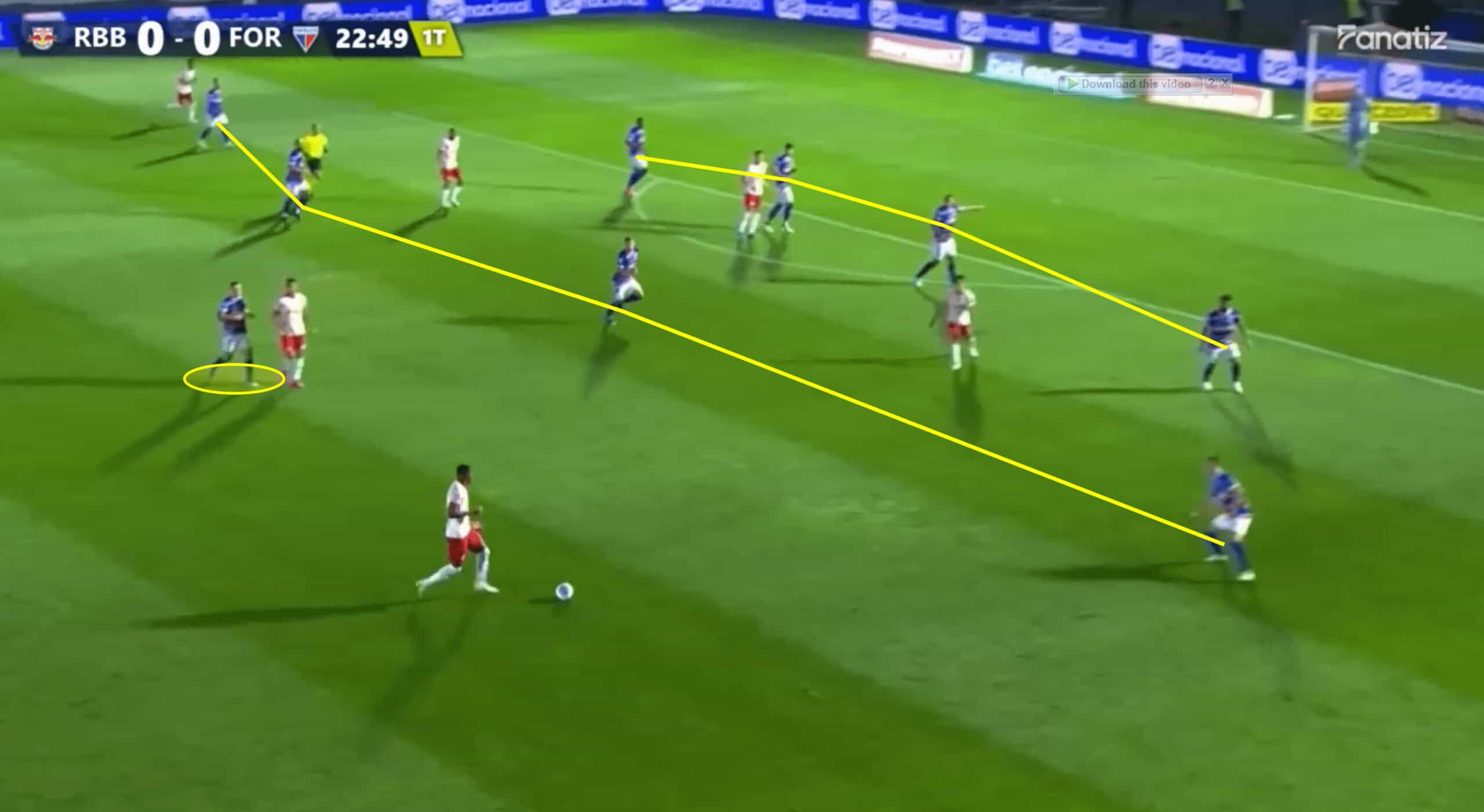
Common formations for successful low-blocks are 4-4-2 and 4-2-3-1 — systems that Fortaleza use frequently.
These formations allow for a good balance between defence and attack.
Players can be sufficiently positioned to provide adequate defensive support while also being effective during transition moments and counterattack scenarios.
In terms of a defensive structure, Fortaleza like to keep a narrow back four, when possible, with the aim of protecting the box.
This heavy, narrow presence allows them to fortify the box, making it hard for the opposition to find a path to goal.
Blocking shots is a direct positive result of that presence, and Fortaleza has blocked 28.2% of the shots they’ve faced this campaign, a number that no other team has matched.
The wide midfielders are responsible for providing that defensive support in wide areas.
They tend to sit a little wider than their teammates at full-back, allowing them to combat any wide threat the opposition may have.
Additionally, this approach can eliminate or limit the chance of a successful attack through penetrative passes.
Take figure 1 above, for example, opposition possession is heading down the right flank, but the man on the ball has little to aim at going forward due to the defensive positioning of Fortaleza.
In these moments, 1v1 scenarios can occur, which requires concentration and defensive application from those wide midfielders, who have the job of forcing the ball into wide and isolated areas (if they can’t steal the ball back).
Defensive duels are a strength for Vojvoda’s team, which has a success rate of 63.2% at the time of writing—the fourth-highest rate this season.
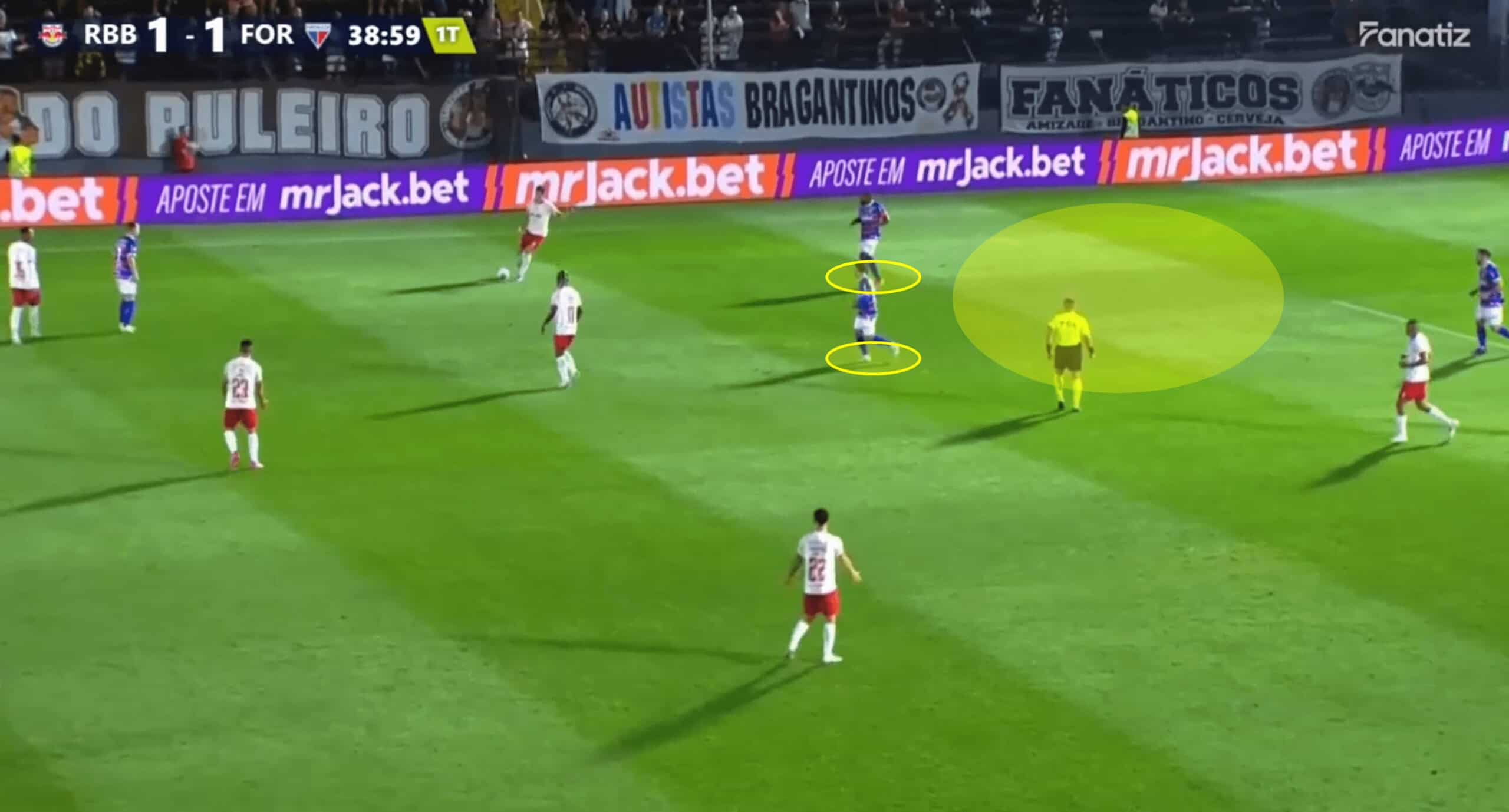
Figure 2 demonstrates the importance of protecting wide space within a low block.
Quite simply, the two highlighted Fortaleza players could easily close down the opponents in front of them, but imagine, if you will, if one or both players rushed towards those opposition shirts.
The wide space down that left flank would be completely there for the taking; it would only require a short and snappy passing combination to exploit that lack of defensive presence in a dangerous area.
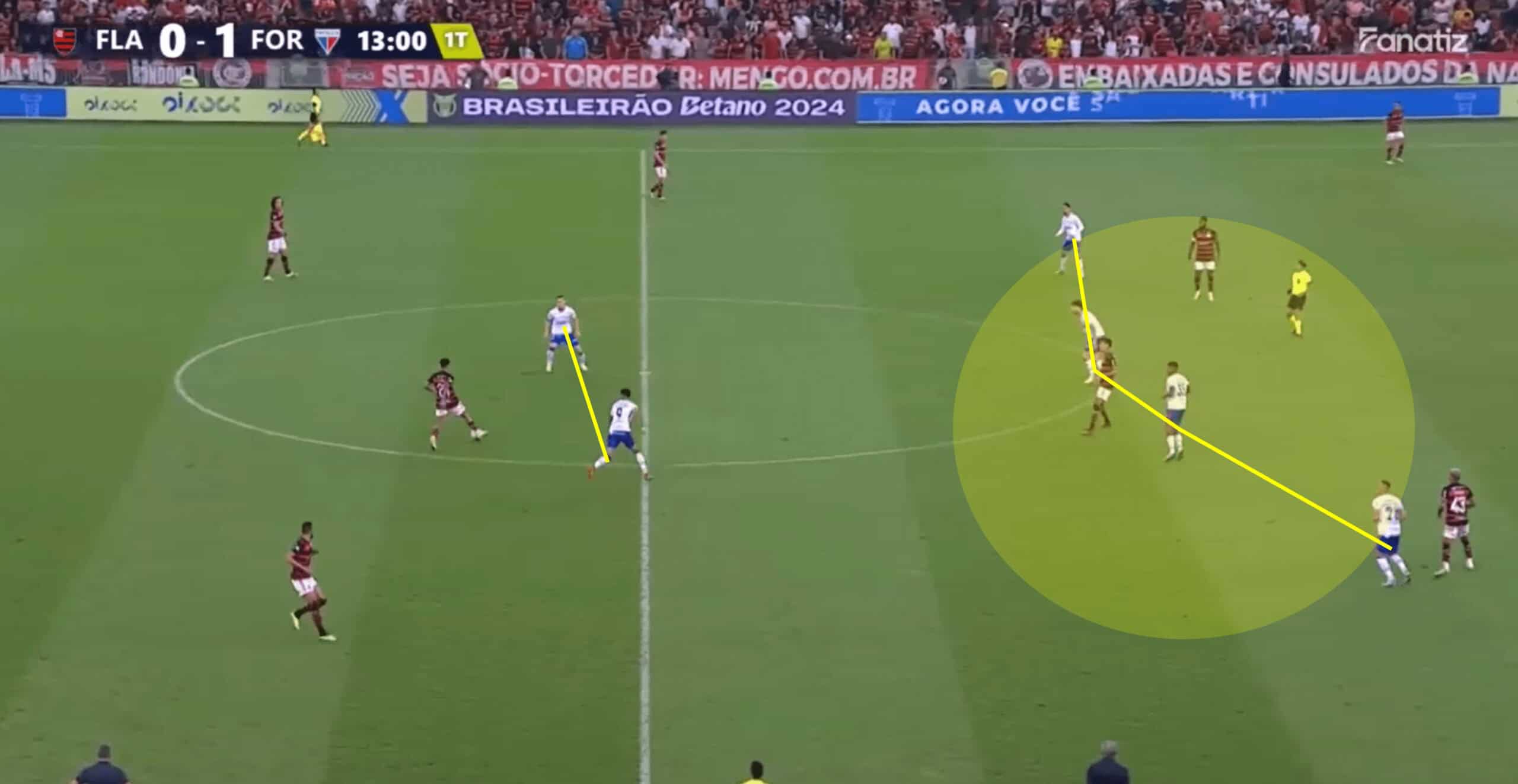
When defending further up the pitch, the focus switches to protecting space in central midfield, with the midfield unit becoming narrow to achieve that goal.
There are no high & wide full-backs either, with the back four still sitting relatively deep and narrow themselves.
The full-bakcs are on alert, though; they are ready to engage the opposition wingers if they do gain possession.
The forwards (or centre-forward and attacking midfielder in a 4-2-3-1 formation) will look to remain close together to try and block any pass through into the central space.
In terms of pressing, the front two will look to chase the ball down in certain areas but will refrain from being dragged out of position.
The data also tells us that Fortaleza bide their time, defensively speaking.
In 2024, they have registered a PPDA of 12.82, which is the fourth-highest in the Brazilian Serie A.
Their midfield unit, in particular, plays an important part in blocking any passes that come their way—Fortaleza’s 36.33 interceptions per 90 minutes are the fifth-highest in the league, which is a credit to their positioning off the ball.
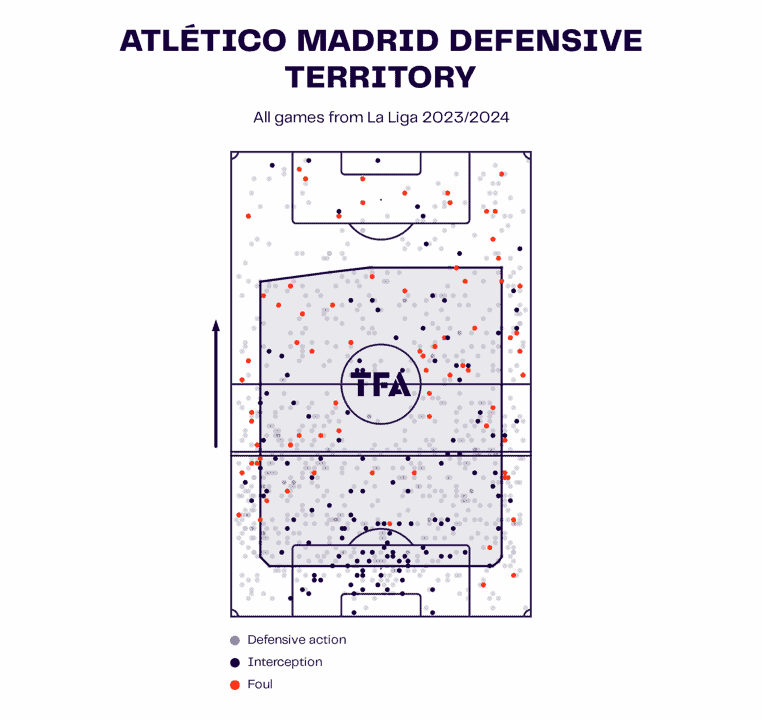
One team famous for their defensive tactics is La Liga side Atlético Madrid, with Diego Simeone seemingly mastering the art of the low block in his 13 years at the club.
While Simeone’s side averages far more possession than most sides that like to soak up the pressure, they still share defensive similarities, as seen in the visual above—a heavy central presence in and around the box provides a nightmare for the opponent, while they are also active in the full-back areas.
As expected, their defensive activity diminishes the further up the pitch you look, but the central focus remains throughout.
Interestingly, while Atlético did have a high counterattack average last season (1.34 per 90), they also had a passing rate of 16.2 – only Real Madrid posted a higher number last season.
Those numbers indicate that, while Atlético is a side that likes to sit deep and wait for the right moment to pounce on the ball, they have the quality to maintain possession in certain moments—but they also possess the ability to hit teams on the break when they choose.
Counterattack Execution
Around the world, we see teams near the bottom of their respective leagues deploying low-block tactics but struggling to pose any major attacking threat.
That leads us to the difference between teams who choose to play in a low block as it suits their players’ playing styles and teams who are forced to defend deeper due to an overall lack of squad quality.
That is why, along with Fortaleza, Atlético Madrid (and other teams) are successful — not only are they playing this way by choice, but they have means of attack, the ability to hurt the opposition when they do have the ball.
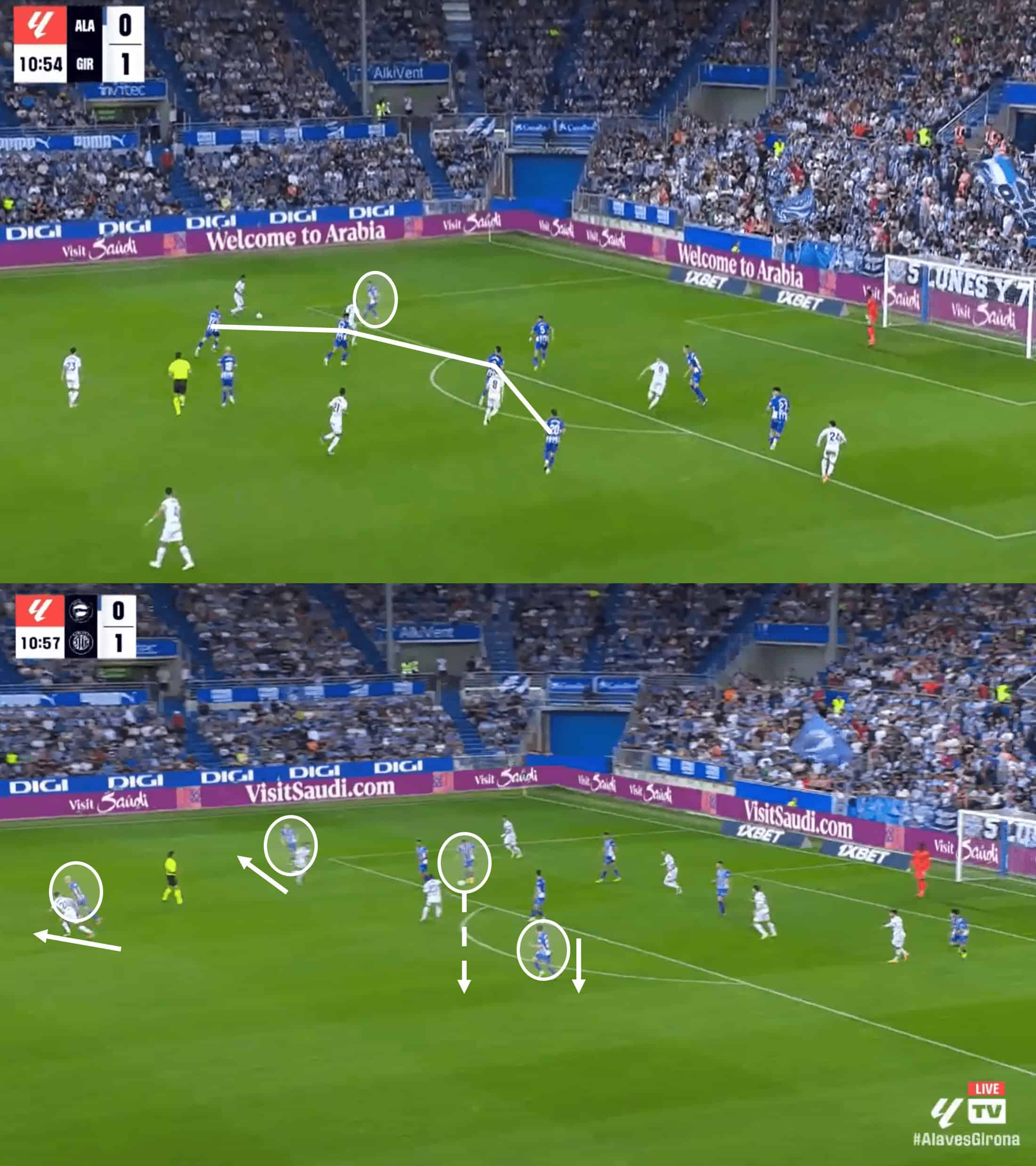
Another La Liga side who are making it work by using low-block tactics is Deportivo Alavés.
The club were promoted back to La Liga after a successful 2022/23 campaign in Spain’s second tier, and they surprised many last season by finishing 10th — just two seasons after they finished rock bottom in the very same division.
Armed with one of the best defensive records in the league, manager Luis García has transformed the club’s fortunes by finding that balance between defending deep and counter-attacking effectively.
Last season, Alavés averaged an astounding 1.82 counter-attacks per 90, which is how they hurt teams the most.
However, it also gets them out of danger, limiting the opposition’s threat.
They like to deploy a narrow midfield unit when defending, with the back four only slightly wider.
In the event of a turnover, however, you can almost see the cogs turn as multiple players make effective movements to provide the team shape with width and attacking outlets, as seen in the image above.
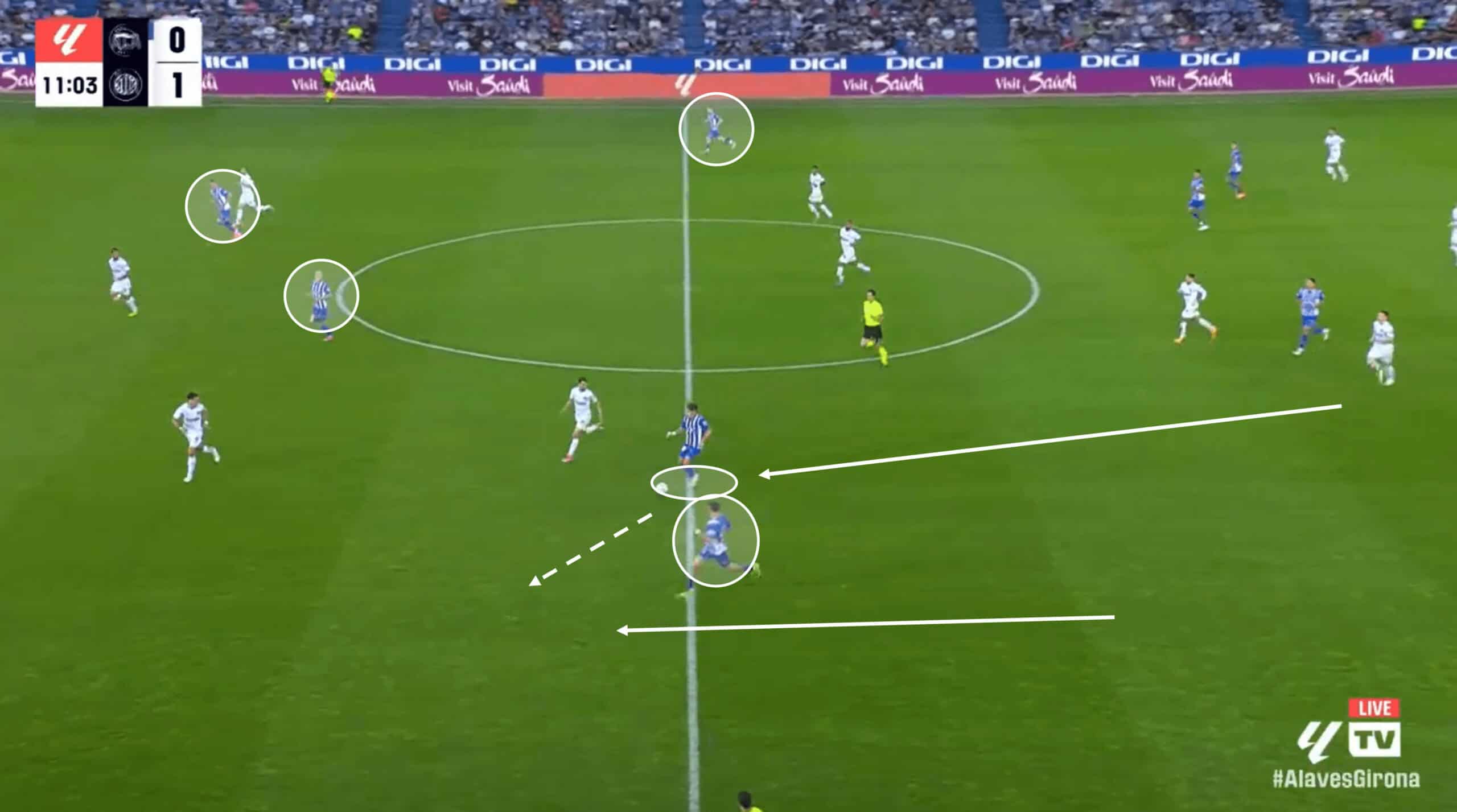
Once you get out of your own defensive quarters, tactically, you have a choice to make.
You can either look to maintain possession and build a sustained period of pressure, just as Atlético Madrid often do, or you can counterattack, which is Alavés’ preferred method.
When choosing this approach, though, the team must show bravery in committing sufficient support to the attack, as you can see in the analysis image above.
Runners down both flanks and central presence are key compartments in an effective counterattack that can hurt the opposition.
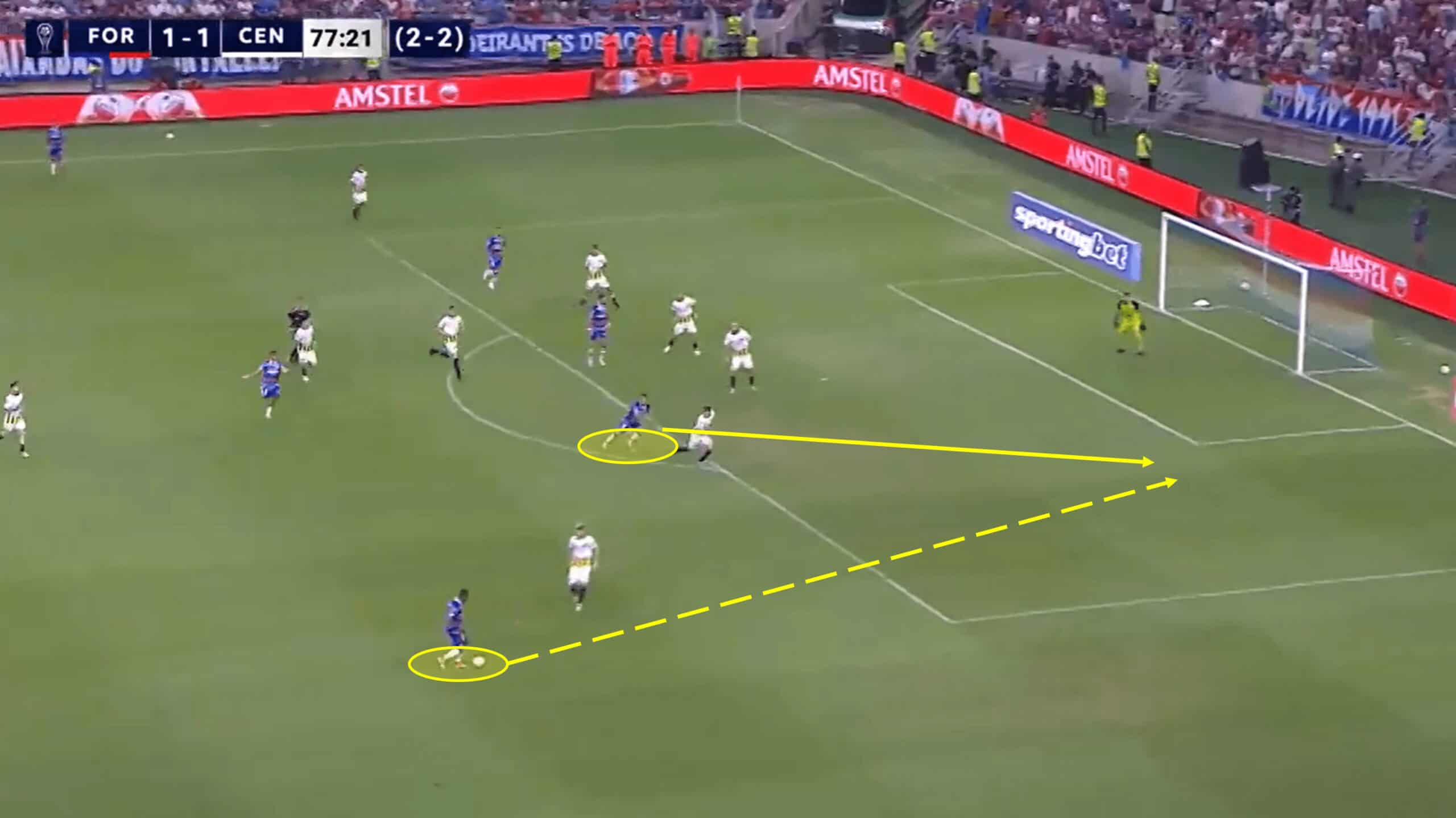
For teams that play the way we’ve discussed in this analysis, attacking chances may be limited, so it is imperative that they are taken—and that means more than just finishing goalscoring opportunities.
Earlier, we mentioned the importance of bravery in attack, and that is displayed again as Fortaleza seemingly have very little on in the image above.
Still, a well-executed through pass into the box was met by the attacker and finished.
That is also a prime example of the importance of understanding the capabilities of your teammates — the passer knew that his teammate would make the run with good timing and pace; the runner knew the passer had the quality to find him.
Not all attacking build-up phases require a boatload of passes.
Fortaleza registered the lowest passing rate in the league this season but still managed to score 30 goals in 24 games.
Weaknesses And Considerations When Using Low Block
With many tactics in modern football, there are areas that come with a risk, tactically speaking — arguably, defensive low-block tactics come with more risks than any other.
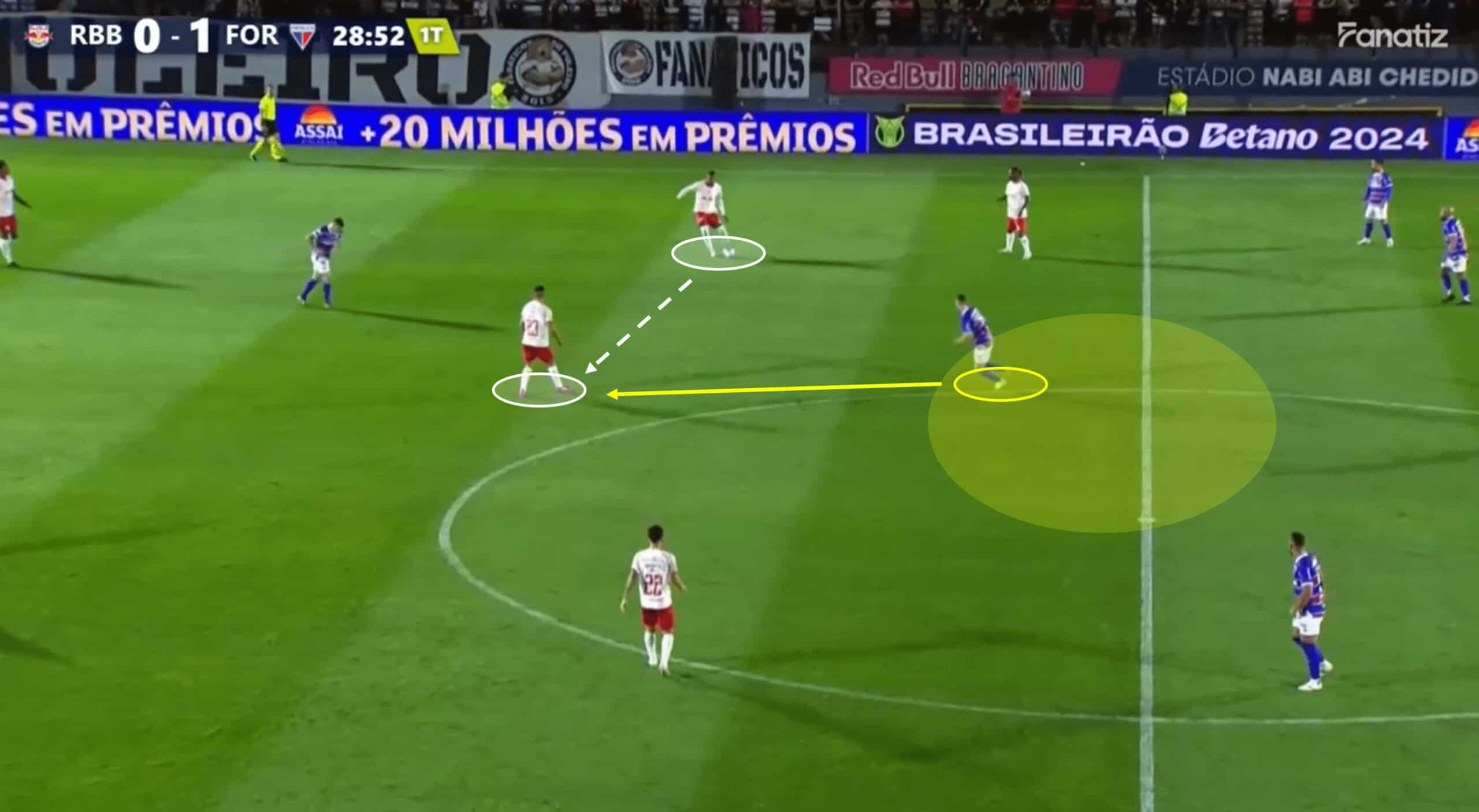
While some low-block sides like to execute a press in certain areas, knowing when and where to do this is absolutely vital — getting it wrong can come with huge consequences.
The image above shows us why players must understand the tactical requirements of their role.
The Fortaleza attacking midfielder has an important positional role in front of the rest of his midfield unit, but temptation gets the better of him, and he rushes out to engage the ball as it arrives at a nearby opponent.
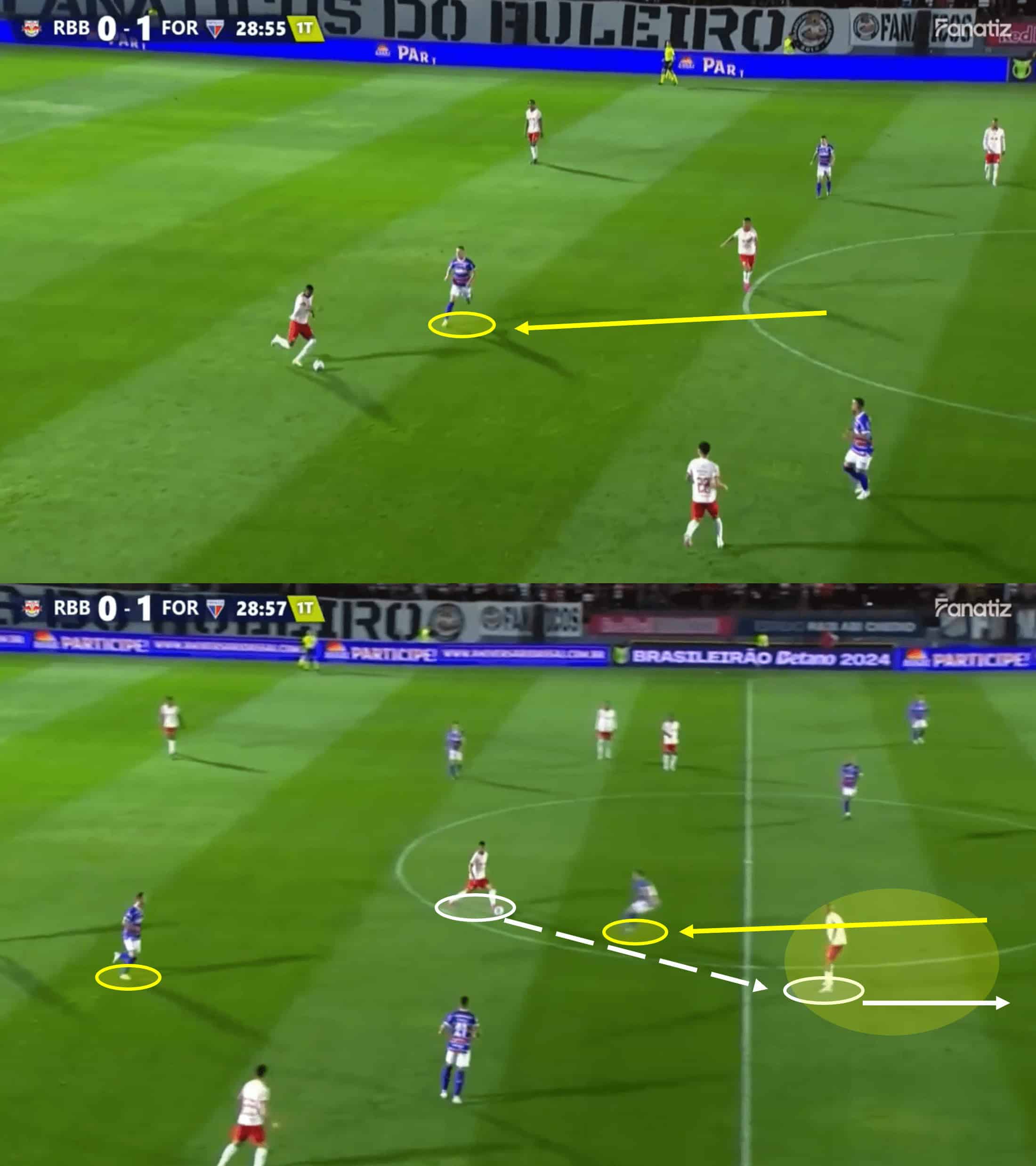
He continues his hunt despite no success and next-to-no damage to the opponent’s possession, leaving him higher than the CF.
Inevitably, this leaves space in midfield that the opposition looks to exploit.
The defensive midfielder tries to combat this by stepping out of his zone and into the zone that should be occupied by the attacking midfielder, but he is too slow, and the opposition simply bypasses his press and, with it, Fortaleza’s immediate midfield presence.
This allows the opposition the chance to push forward with an injection of speed to their actions as they look to capitalise on a small yet costly individual error.
This all comes back to the aforementioned point of players understanding the tactical requirements of their role.
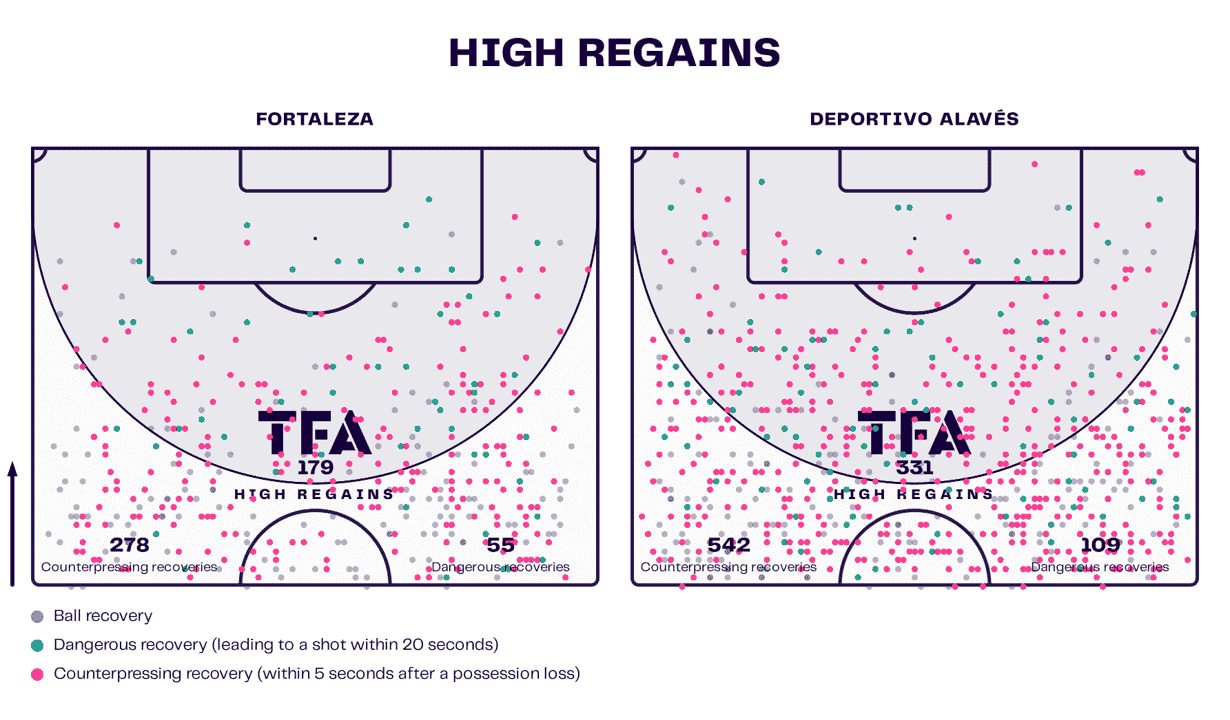
You’ll notice that this analysis segment is called ‘weaknesses and considerations’ – not just ‘weaknesses’.
And that is what we are discussing here, the considerations that managers must go through when coaching their team to play under these tactics.
The image above shows the defensive activity in high areas of both Fortaleza and Deportivo Alavés.
The important note here is that both sides have more counterpressing recoveries than high regains or dangerous recoveries, and that is no coincidence.
Low-block teams are usually patient, waiting for the right moment to swoop in and dispossess the opponent.
Transitions are also key moments as they look to stop the opponent from gaining momentum by counterpressing them.
This can be an effective method, but the consideration here isn’t whether they can apply their primary tactics but whether they can adapt.
Scenario – Fortaleza are 1-0 down in the 85th minute; you’d have to imagine that they would switch things up and deploy a more attacking approach with more aggression and intensity.
It sounds like an easy transition, but managers and head coaches must have plans in place for players to have the tactical wherewithal that allows them to be more effective in a more attacking system, and that means pressing higher as a team without leaving yourself exposed in certain areas.
Conclusion
In this analysis, we’ve examined the low-block tactics of three teams, with Fortaleza as the primary side.
While all three have little differences in certain corners of their tactics, many of the principles show similarities.
In a nutshell, the three managers have been successful in finding a way to have their team defend adequately in a low block while also being dangerous on the break on a consistent basis.
Fortaleza, as the focus team, will look to continue on their current tactical path in the hopes that it will lead them to the league title.

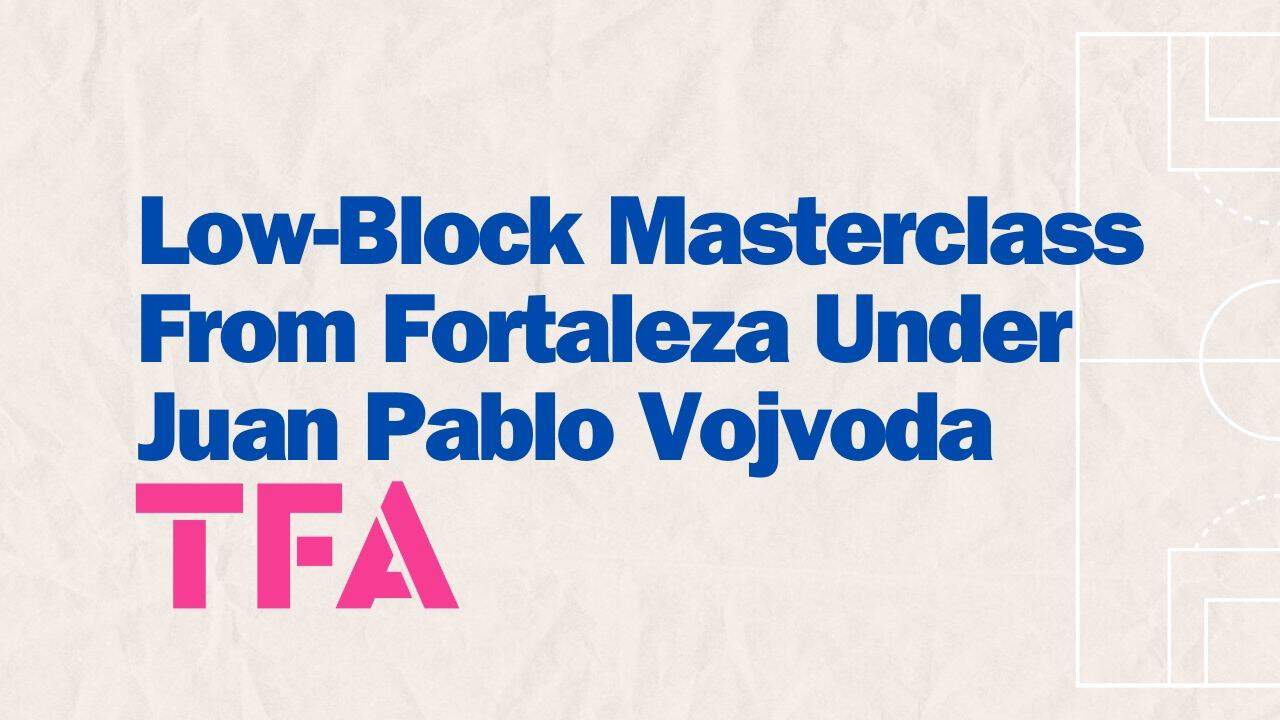




Comments